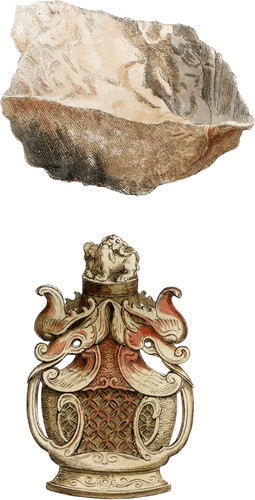 Enlarge
Enlarge
Exotic Mineralogy
Bildstein
- Syn.
- Pierre de Lard. Romé de Lisle, II. 520.
- Bildstein. Brochant, Werner, &c.
- Agalmatolithe. Klaproth, &c.
- Talc glaphique.* Haüy Traité, III. 256. Tabl. 68.
- Agalmatolite. Aikin, 202.
Various are the conjectures respecting this substance; but so little is known of it, or even the substances to which it is nearest related, except what is in itself contradictory, that no decision can be made respecting it. The non-existence of Magnesia in it distinguishes it from Steatite; nevertheless they have both been considered as compact varieties of Talc, first by Hatty, and more lately by Bournon: its analysis approaches more nearly to that of Mica, or Lepidolite, as it seems to bear the same relation in external characters to Mica that Steatite does to Talc, but agrees better in the constituent parts. It has hitherto been brought from China, carved into various utensils, or grotesque figures, which are commonly said to be formed of boiled rice. It has also been found at Nagyag in Transylvania. Aikin mentions its occurrence at Glyder Bach in Caernarvonshire, but upon what authority I know not. It may be distinguished from Steatite by its not being acted upon or disintegrating when wetted. The following are the analyses most to be relied upon:
| By Vauguelin, | Of the Chinese, by Klaproth, | Of that from Nagyag by do. | |
|---|---|---|---|
| Silica | 56 | 54.50 | 55.0 |
| Alumina | 29 | 34 | 33.0 |
| Lime | 2 | ||
| Potash | 7 | 6.25 | 7.0 |
| Iron | 1 | 0.75 | 0.5 |
| Water | 5 | 4. | 3.0 |
| 100 | 99.50 | 98.5 |
I have represented a fragment of the stone, and beneath it an essence bottle carved out of it, as it may be cut nearly as easily as chalk, with an appearance something like Ivory.
- * Derived from γλαφω and signifies fit for carving or sculpture; distinct from graphique, which has been quoted for Haüy’s word.

